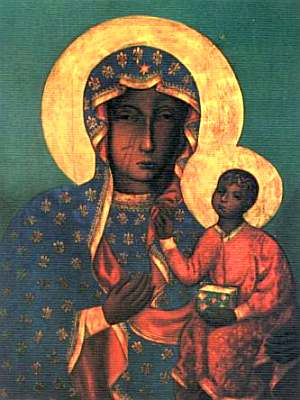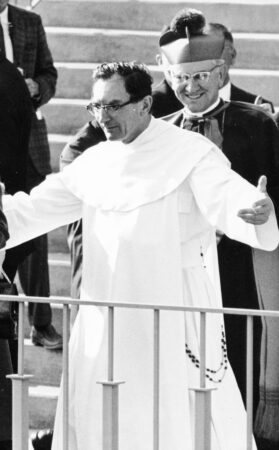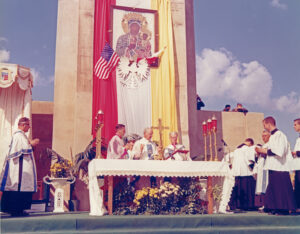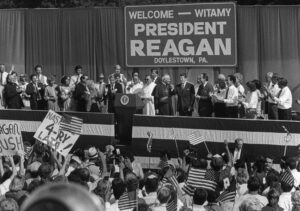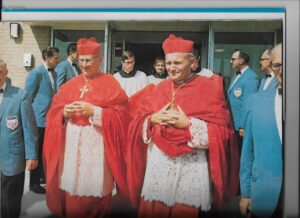On the outskirts of Doylestown, Father Michael Zembrzuski, a member of the Order of Saint Paul the First Hermit, had a vision to erect a shrine to Poland’s revered Marian icon: Our Lady of Czestochowa. It is said that the image was painted by Saint Luke the Evangelist. Until 1948, Father Zembrzuski headed the Hungarian province of the community founded by Blessed Eusebius of Esztergom. He was ousted from Hungary by the Communist government of the Hungarian Peoples Republic and, after a few years in Rome, traveled to the United States in 1951. After traveling and preaching at various Polish parishes here and in Canada, Father Zembrzuski wanted to find a way to strengthen and revive polish spirit and pride.
In 1953, after receiving permission from the Holy See, he bought land near Doylestown, and turned the houses on the property into living quarters for monks and the barn into a temporary shrine while he raised money for a permanent building. Inside the barn is an image of Our Lady of Czectochowa, and was blessed and dedicated on June 26, 1955. Not long after, pilgrim groups started to vist the Shrine, mainly from Polish parishes in Philadelphia. A monastery was also established on the property, and the Superior of the Order sent over more religious. By 1956, the four members of the Pauline Order at the new site were Fathers Michael Zembrzuski and Stanley Nowak, and brothers Casmir Pasnik and Mark Mitura.
As news of the Shrine quickly spread, the barn was becoming too small for the large number of pilgrims. The vision of a larger Shrine was realized when a solemn procession was led to nearby Beacon Hill on September 17, 1963. A year later, Cardinal Krol preside over a groundbreaking ceremony on the feast of our Lady of Chestochowa. The goal of the Pauline Fathers was to have the new Shrine completed by 1966: the millennium of the founding of Poland. In less than two years, the area went from a construction site to a grand Shrine celebrating Polish culture. The Sanctuary of the Lower Church is modeled after the original Shrine at the Jasna Gora Monastery in Poland. The main Sanctuary contains large stained-glass windows, on both sides, depicting the history of Christianity in Poland and in the United States. On October 16, Cardinal Krol formally dedicated the new Shrine in the presence of thousands of pilgrims, including President Lyndon B. Johnson. In his speech, Mr. Johnson praised Polish contributions to this country and called for closer cooperation today in trade and cultural areas with the present Polish Government. “We have not forgotten your friends and relatives in Poland,” the President said. “We have not forgotten the traditional bonds that have united our peoples since our earliest days as a nation.”
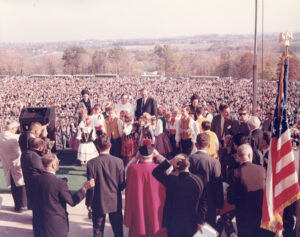
President Lyndon B. Johnson with children in traditional Polish attire and congregants at the Dedication Mass, 10/16/1966
Over the years, the Shrine called the “American Czestochowa” has hosted many distinguished guests. In addition to President Johnson, two other presidents of the United States have visited: Ronald Reagan in 1984 and then-Presidential Candidate George H.W. Bush in 1980. Polish government officials have also visited the Shrine: Solidarity movement leader Lech Walesa in 1989 and President Andrzej Duda in 2024. When it comes to Catholic history and the Shrine, the American Czestochowa has been graced with two visits by Karol Cardinal Wojtyla, the future Saint John Paul II. The first was in 1969 and the second was in 1976 when he was here for the 41st International Eucharistic Congress. In his sermon given in 1969, Cardinal Wojtyla talked about the need for those of Polish descent to be close to Mary, no matter where they go: "“Apparently Poles will not go anywhere in the world without Czestochowa. This is our fate and a blessed fate. Poles will not go anywhere without Czestochowa. And without the image of Our Lady of Czestochowa, who speaks to them, tells them about themselves. It is such a special image that depicts the Mother of God and tells us Poles about ourselves!”


